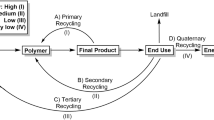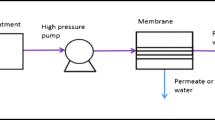Abstract
Background, aim and scope
Lubricants are used in numerous applications in our society, for instance, as hydraulic fluids. When used in forestry, 60–80% of these hydraulic fluids are released into the environment. This is one of the reasons for the growing interest for developing and utilising hydraulic fluids with good environmental performance. Another driving force in the development of hydraulic fluids is to replace fossil products with renewable ones. The aim of this paper is to investigate the environmental impact of two types of hydraulic fluids, one based on mineral oil and one on vegetable oil. The difference in environmental impact of using chemical or biocatalytic production methods is also assessed.
Materials and methods
This life cycle assessment is from cradle-to-gate, including waste treatment. A complementary, laboratory, biodegradability test was also performed. The functional unit is 1 l of base fluid for hydraulic fluids, and mass allocation is applied. A sensitivity analysis is performed to assess the impact of the energy used and of the allocation method. The impact categories studied are primary energy consumption, global warming potential (GWP), eutrophication potential (EP), acidification potential (AP), photooxidant creation potential (POCP) and biodegradability.
Results and discussion
The contribution to GWP and primary energy consumption was higher for the mineral oil-based hydraulic fluid than the vegetable oil-based hydraulic fluids. The contributions to EP and AP were higher for the vegetable oil-based hydraulic fluid than the mineral oil-based one. The vegetable oil-based hydraulic fluid had better biodegradability than the one based on mineral oil. The impact of production method was minor, thus the biocatalytic method gives no significant advantage over chemical methods concerning energy and environmental performance.
Conclusions
For the environmental impact categories GWP, POCP and primary energy consumption, hydraulic fluids based on rapeseed oil make a lower contribution than a mineral oil-based hydraulic fluid. For EP and AP, the contributions of TMP oleate are higher than the contribution of mineral oil-based hydraulic fluid. The difference between the chemically catalysed method and the ezymatically catalysed method is negligible because the major environmental impact is due to the production of the raw materials. The vegetable oil-based hydraulic fluid, TMP oleate, was more biodegradable than the mineral oil-based hydraulic fluid.









Similar content being viewed by others
References
Andersson L, Severinsson M (1996) Partial Life Cycle Assessment of Pentaerytritol Production, Internal report (Confidential) Perstorp Regeno
Bartels T, Bock W, Braun J, Busch C, Buss W, Dresel W, Freiler C, Harperscheid M, Heckler R-P, Hörner D, Kubicki F, Lingg G, Losch A, Luther R, Mang T, Noll S, Omeis J (2005) Lubricants and lubrication, Ullmann’s encyclopedia of industrial chemistry. Wiley-VHC Verlag GmbH & Co KGaA, Weinheim
Bernesson S, Nilsson D, Hansson P-A (2004) A limited LCA comparing large- and small-scale production of rape methyl ester under Swedish conditions. Biomass Bioenerg 26:545–559
Binol (2010) http://www.aak.com/en/ProductsApplications/Binol-biolubricants/Products/Forestry--Construction/
Blanch HW, Clark DS (1997) Biochemical engineering. Marcel Dekker, Inc., New York
Börjesson P, Tufvesson LM (2010) Agricultural crop-based biofuels—resource efficiency and environmental performance including direct land use changes. J Clean Prod. doi:10.1016/j.jclepro.2010.01.001
Boustead I (2005a) Eco-profiles of the European Plastics Industry PROPYLENE, A report for Plastics Europe, March 2005
Boustead I (2005b) Eco-profiles of the European Plastics Industry PHENOL, A report for Plastics Europe, March 2005
Boustead I (2005c) Eco-profiles of the European Plastics Industry TOLUENE, A report for Plastics Europe, March 2005
Boustead I (2005d) Eco-profiles of the European Plastics Industry PENTANE, A report for Plastics Europe, March 2005
Boustead I (2005e) Eco-profiles of the European Plastics Industry CRUDE OIL, A report for Plastics Europe, March 2005
Cederberg C, Flysjö A (2008) Emissions of greenhouse gases in a life cycle perspective and use of energy and land in production of RME from Swedish rapeseed, Report P80453, The Swedish Institute for Food and Biotechnology
Energetics Incorporated (2007) Energy and Environmental Profile of the U.S. Petroleum Refining Industry, U.S. Department of Energy Industrial Technologies Program (http://www.energetics.com/resourcecenter/products/studies/Documents/PetroleumRefining-Energy-EnvironmentalProfile.pdf)
European Commission (2005) Official Journal of the European Union, L 118/26, 5.5.2005
Svensk Författningssamling (SFS) Förordning (1993:1268) (2008) om spillolja, Miljödepartementet 1993-11-18, ändrad tom, 250
Hatti-Kaul R, Törnvall U, Gustafsson L, Börjesson P (2007) Industrial biotechnology for the production of bio-based chemicals—a cradle-to-grave perspective. Trends Biotechnol 25(3):119–124
IPCC (2006) N2O emissions from managed soils and CO2 emissions from lime and urea application, Guidelines for National Greenhouse Gas Inventories Vol 4, Chapter 11
Johnsson H, Mårtensson, K (2002) Kväveläckage från svensk åkermark –Beräkningar av normalutlakning för 1995 och 1999, Rapport 5248, Swedish Environmental Protection Agency
Lämsä M (1996) Process for preparing a synthetic ester from a vegetable oil, International patent number WO 96/07632
Lantz M, Ekman A, Börjesson P (2009) Systemoptimerad produktion av fordonsgas En miljö- och energisystemanalys av Söderåsens biogasanläggning, Report 69, Environmental and Energy System Studies, Lund University
Lynch TR (2008) Process chemistry of lubricant base stocks. Taylor and Francis Group CRC New York, chapter 1, pp 1–20
Mårtensson P, Svensson M (2009) Miljösystemstudie svensk RME och etanol i tunga fordon –en kunskapsuppdatering, Masters Thesis, Lund University
McManus M (2001) Life cycle assessment of rapeseed and mineral oil based fluid power systems, Dissertation, University of Bath
Möller UJ, Young D (2007) Hydraulic fluids. Ullmann’s encyclopaedia of industrial chemistry. Wiley-VCH Verlag GmbH & Co., KGaA, Weinheim
Nielsen PH, Oxenboll KM, Wenzel H (2007) Cradle-to-gate environmental assessment of enzyme products produced industrially in Denmark by Novozymes A/S. Int J Life Cycle Assess 12(6):432–438
Nilsson A (2006) Kartläggning och analys av diesel- och hydrauloljeförbrukning hos Sydveds entreprenörer –miljöpåverkan och åtgärdsförslag, Masters Thesis, Lund University
Nordling C, Österman J (1999) Physics handbook, Studentlitteratur
Norrby T, Kopp M (2000) Environmentally adapted lubricants in Swedish forest industry—a critical review and case study. Ind Lubr Tribol 52(3):116–124
OECD (1992) OECD Guideline for testing of chemicals
Orellana Coca C, Gaber Y, Abd Ghani N, Lämsä M, Hatti-Kaul R (2011) Synthesis of biolubricants using heterogenous catalysis, Manuscript submitted to Journal of molecular catalysis
Pettersson A (2007) High-performance base fluids for environmentally adapted lubricants. Tribol Int 40:638–645
Schmidt JH (2007) Life cycle assessment of rapeseed oil and palm oil. Part 3: Life cycle inventory of rapeseed oil and palm oil. Dissertation, Aalborg University
Schneider MP (2006) Plant-oil-based lubricants and hydraulic fluids. J Sci Food Agric 86:1769–1780
Solomon S, Manning M, Dahe Q (2007) Physical science basis—Working Group I contribution to the Fourth Assessment Report of the IPCC. Cambridge University Press, Cambridge, UK
Swedish Environmental Protection Agency (2009) http://www.naturvardsverket.se/sv/Klimat-i-forandring/Minska-utslappen/Verktygslada-for-kommuner-och-foretag/Emissionsfaktorer/ Accessed 2 April
Tufvesson LM, Börjesson P (2008) Wax production from renewable feedstock using biocatalysts instead of fossil feedstock and conventional methods. Int J Life Cycle Assess 13:328–338
Uosukainen E, Linko Y-Y, Lämsä M, Tervakangas T, Linko P (1998) Transesterification of trimethylolpropane and rapeseed oil methyl ester to environmentally acceptable lubricants. JAOCS 75(11):1557–1563
Uppenberg S, Almemark M, Brandel M, Lindfors L-G, Marcus H-O, Stripple H, Wachtmeister A, Zetterberg L (2001) Miljöfaktabok för bränslen Del 2. Bakgrundsinformation och teknisk bilaga, IVL rapport B 1334B-2
Våg C, Marby A, Kopp M, Furberg L, Norrby T (2002) A comparative life cycle assessment of the manufacture of base fluids for lubricants. J Synth Lubr 19(1):39–57
Wang M, Lee H, Molburg J (2004) Allocation of energy use in petroleum refineries to petroleum products, implications for life-cycle energy use and emission inventory of petroleum transport fuels. Int J Life Cycle Assess 9(1):34–44
Welty JR, Wicks CE, Wilson RE, Rorrer G (2001) Fundamentals of momentum, heat and mass transfer, fourth edition. Wiley, New York
Willing A (2001) Lubricants based on renewable resources—an environmentally compatible alternative to mineral oil products. Chemosphere 43:89–98
Acknowledgements
Our greatest debt of thanks is due to MISTRA for the financial support to the Greenchem project of which this study is a part. Greenchem is a collaboration between Lund Unversity and several Swedish industries. We would also like to thank the anonymous reviewers for valuable comments.
Author information
Authors and Affiliations
Corresponding author
Rights and permissions
About this article
Cite this article
Ekman, A., Börjesson, P. Life cycle assessment of mineral oil-based and vegetable oil-based hydraulic fluids including comparison of biocatalytic and conventional production methods. Int J Life Cycle Assess 16, 297–305 (2011). https://doi.org/10.1007/s11367-011-0263-0
Received:
Accepted:
Published:
Issue Date:
DOI: https://doi.org/10.1007/s11367-011-0263-0




